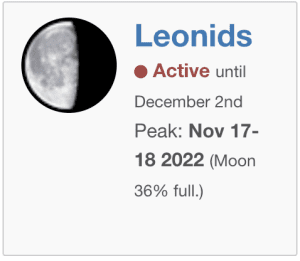Feast your eyes on the beauty of the night sky this month because two meteor showers are going to grace us with their presence in the next few days.
The Taurids and Leonids meteor showers are set to peak this November and if the skies are clear and you have a chance to see them for yourself, we got you covered on the important things you’d need to know.
Recent Posts:
Hold the double double: Here’s how much Canadians spend on coffee every month
Justin Trudeau will appear on the new ‘Canada’s Drag Race’ series
The Taurids
First up is the Taurids meteor showers, which is composed of two: Northern Taurids and Southern Taurids. According to NASA, these showers occur every year from September to November.
These showers, which are seen as fireballs in the sky, are created when the Earth passes through a wide stream of debris left by Comet Encke.
Both the Southern and Northern showers are currently active and when that occurs at the same time, in late October and early November, sometimes there’s an increase in fireball activity, according to the American Meteor Society(opens in new tab),
“There seems to be a seven year periodicity with these fireballs. 2008 and 2015 both produced remarkable fireball activity. 2022 may be the next opportunity,” note the AMS.
The Southern Taurids have already peaked but the Northern Taurids will next peak on the nights of November 11 and 12, 2022. According to SPACE.com, the best time to see the Taurid meteor shower is around midnight “when the shower’s radiant, the Taurus constellation, is high in the sky.”

If you can’t catch it this weekend, don’t worry, there’s still another meteor shower that peaks next week.
Leonids
The next meteor shower falling this month is the Leonids. They’re active throughout the month of November and according to NASA, are considered to be a major shower.
Though they’re composed of “dusty bits of debris left behind by comet Tempel-Tuttle as it orbits the Sun,” they are truly bright and colourful meteors.
And not only that, they’re pretty fast too – with traveling speeds of 71 km per second, which makes them one of the fastest meteors that occur.
The Leonids shower can have meteor rates as low as about 15 meteors per hour. But about every 33 years, we may experience a Leonid storm that’s so big, it can “peak with hundreds to thousands of meteors seen per hour depending on the location of the observer.”
As for when they’ll peak this month, NASA shares that it’ll occur after midnight on November 18, “with something like 15 to 20 meteors per hour under clear, dark skies.” You might have trouble seeing the fainter meteors as the Moon will be about 35% full.

It’s been a bit chilly out there so make sure you bundle up for a night under the big, mysterious sky. There are a few Toronto parks where you can watch the meteor showers, weather permitting, too. Lay on your back, look up at the sky and let the show begin.

